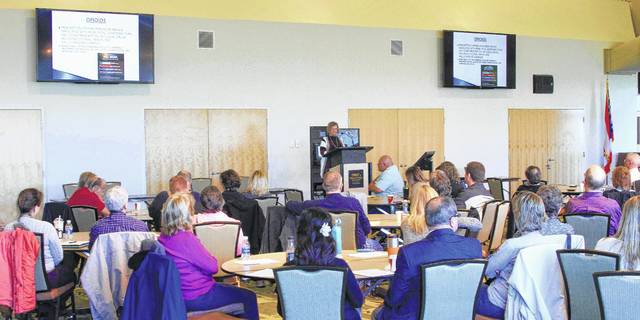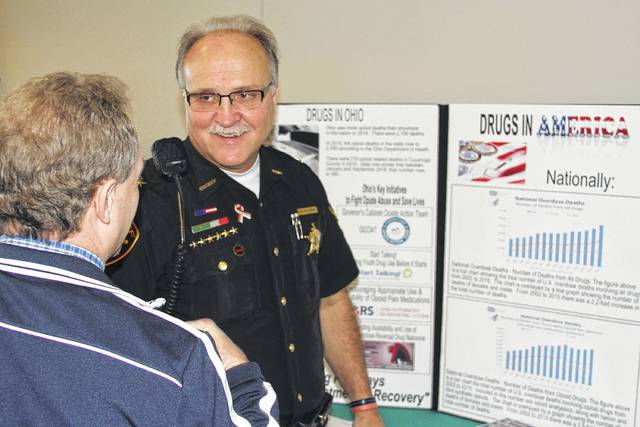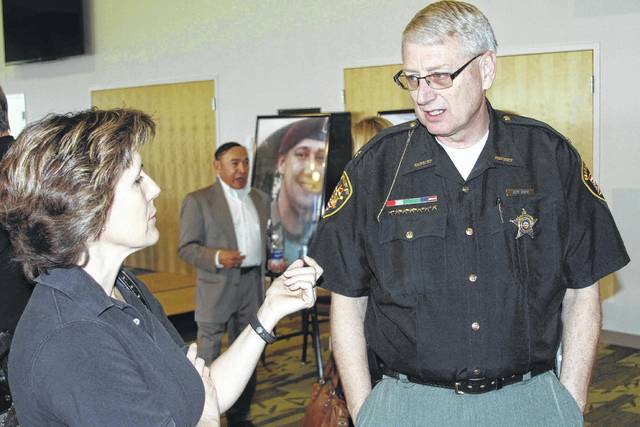



CELINA — A capacity crowd of concerned citizens attended the 2017 Auglaize/Mercer County Drug Symposium held at the Wright State University’s Dicke Center, 7600 State Route 703 Celina. This is the third symposium since the inception of the Auglaize/Mercer County Drug Coalition in 2014.
Robert Gill, MD, physical adviser of Grand Lake Health System, said the Auglaize/Mercer County Drug Coalition is a multidisciplinary group of professionals from Auglaize and Mercer counties who have recognized that a need exists to fight the drug epidemic that has besieged the counties. The coalition is made up of law enforcement, medical providers, mental health specialists and educators that are working together for the citizens of Auglaize and Mercer County.
“In 2014, in light of the alarming statistics, we decided we needed to find a better way to fight the battle with drugs,” said Gill. “Our mission is to promote and support the concept of drug free communities in our counties so our citizens can prosper without the problems of drug abuse and addiction. Our vision is to provide the educational resources necessary so our citizens and youth are aware of the pitfalls of drug abuse and addiction. To support law enforcement in their quest to keep the citizens safe from the consequences of drug problems in their communities and to support and promote those services that provide care to our citizens afflicted by the use of drugs.”
Gill shared a brief history of the coalition that began in January 2014 when Auglaize County Sheriff Allen Solomon and Mercer County Sheriff Jeff Grey met to discuss how they could work together to stem the rising problem of drug abuse and addiction. The first Drug Symposium was held March 29, 2014. Gill said over the next three years a committee met with many citizens, both private and professional.
“We sought their guidance and ideas to find better ways to fight the drug problem in our counties. Some of our citizens still believed that we did not have a drug problem so we brought awareness to our communities that the problem was here and that we had to find ways to deal with it. During this time period we added two essential individuals to our committee: Dyesha Darby from Mental Health and Recovery Services of Allen, Auglaize and Hardin Counties and Laura Sanford from Mercer County Foundations. They added the needed dimension of mental health and prevention. We also talked to educators at our meetings. We had our second Symposium in 2015 and endeavored to have one in 2016 but all the right people did not come together to make that happen.”
The coalition established the Drug Education Fund in November 2014 through the Foundation at Grand Lake Health System to provide monies to buy supplies and materials for the schools and conferences. One plan includes providing a display case in schools to provide educational material for students to read about drug abuse and addiction. If allocated, the location, design, and content of the material would be approved by the school system. The content and materials will also be provided by the coalition and approved by the school systems as well.
“The idea is to have a steady stream of information that is up to date to educate our youth about drugs and addiction. Thus far we have received monies from grants, community groups and private donations to keep this fund active. The fund is monitored by five individuals including the two sheriffs to make sure it is wisely utilized. We come together today to educate the public about what we are doing in our counties and to tell them about the new drug problems facing our counties, state, and country. We thank you for your participation,” Gill said.
After hearing national and state statistics on drug abuse, attendees heard from Juan Torres, MD, MPH, medical director of the Auglaize County Health Department, Auglaize County DARE Officer Sam Blank followed sharing information about apps for children’s games like Pokemon that are available for drug education.
“DARE also has a 17-week program with a diploma and a T-shirt for those who finish the course,” said Blank.
“This problem is real.” said Amy Poor, BS, MSM: Mercer County Health commissioner. “It is no longer something we can escape from and our German Catholic culture is no excuse for binge drinking, which a recent survey indicated to be as high as 43 percent among those questioned. Drinking often leads to other addictions as well and is foundational to local drug problems.”
Susan Amour, LSW, LICDC-CS, therapist with Coleman Professional Services, talked about counselling and therapy available for those with drug addiction.
“Our goal is to provide the best treatment and the least restrictive environment. We deal with suicidal, homicidal individuals that are a risk to others or their self. When people are clean and sober they make good decisions. Addicts are in another world. They can’t reason or think with a ‘high-jacked brain.’ There is a misconception about the dangers associated with different drugs. ‘Huffing’ is just as dangerous as heroin. Addiction is a brain-based disease. People are looking for the best high they can get before they ‘fall-out’ or die,’” Amour said.
Steve Schierholt, executive director for the State of Ohio Board of Pharmacy, shared information about new legislation designed to thwart drug abuse made possible by illegal drug prescriptions.
“We are working to eliminate opportunities for abuse of the system, like computer programs to cross-reference patient prescriptions and to look for abuse and illegal activity,” said Schierholt. “We strive to close loopholes in legislation and control insurance involvement and fraud.”
Concerning the legalization of marijuana, Schierholt said, “If I were king for a day I would stop legalizing marijuana simply because of the related health risks and potential abuse. We are working to put restrictions in place to curb the bad effects of this new legislation.”
Schierholt 74 percent of deaths related to heroin were connected to legal use of pharmaceutical drugs prior to the addiction of heroin which stressed the need to curb or stop the abuse of prescription drugs.
Attendees heard testimonials from Jackie Sheridan and Pastor Randy Davis from “A Better Life- Briana’s Hope,” a faith-based organization to help those who have experienced the pitfall of drugs.
“Drugs, you think you have control but you don’t … At 17 I couldn’t remember the prior 2 ½ years,” said Sheridan, noting addiction never leaves. “I had a tragic home life and a mother and brother who were addicted as well. My brother joined the army to get away from drugs and was severely injured. The V.A.’s answer was to give my brother more drugs which was the last thing he needed; he wound up homeless and on the street. I ended up raising his children along with my own and eventually my brother died of a drug overdose and my mother later died by taking prescription drugs.”
Davis said, “We have a killer on the loose in Mercer and Auglaize Counties,” and told the story of Briana DiBattiste-Dunkirk who was announced missing on June 16, 2014, after being involved in ongoing illegal drug activity. Her mutilated body was found on Sept. 1 in Jay County, Indiana. Briana’s death fostered a faith-based support group that now has nearly 20 chapters in Indiana with hopes of establishing chapters in Ohio as well. Contact Davis at 765-730-4979 if a club, group, organization or church would like to schedule a guest speaker.
Gill shared information about the legalization of marijuana in Ohio before hearing from educators Kelly Tebbe- Auglaize County ESC, Dr. Ken Schmieing from Celina, and Justin Firks from Fort Recovery. Before closing, the meeting ended with a question and answer session.
For more information on how to educate children about the potential dangers of drugs, parents may sign up to receive tips at starttalking.ohio.gov/parenttips or call Ann Frazier with the Ohio Department of Education at 614-728-6946 or email [email protected].





